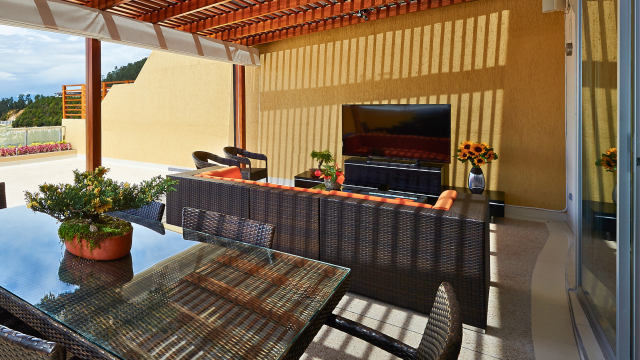Upgrading your outdoor space with a TV can be a fun way to blend indoor and outdoor living, especially when entertaining. The process might seem daunting, but with the right hardware and placement, it’s actually a pretty simple DIY job.
Choose the right TV
The first thing to consider when choosing an outdoor TV is where you’ll be putting it and what kind of sun exposure the area gets. TV companies sell full shade, partial sun, and full sun models, so make sure you take that into account. You can also consider the time of day you generally plan to use your outdoor TV. If it’s after dark, a screen that’s less bright will likely work, while one you plan to use under full daylight conditions will need to be significantly brighter. If you only plan to use your TV at night, you can also choose to use a projector and screen for a larger image at a lower cost. However, you will need to bring the projector indoors overnight or cover it well to keep it from getting damaged by moisture or dirt.
Choose the right hardware
Mounting your outdoor TV can be as simple as mounting one for indoor use, but you should make sure that the hardware you choose is as water resistant as your TV to avoid damage from a broken hanging bracket, for example. A good outdoor bracket will be waterproof and weatherproof, and it should be able to tilt so that you can get the best view. To attach your mounting bracket, you should also make sure to use good quality screws that are intended for outdoor use as well.
Invest in a cover
Even though an outdoor television is designed to withstand some of the outdoor elements, a cover will extend its life and better protect it from moisture, dust, and debris when you’re not using it. Cutting down on rain and dirt will keep all the inputs for power and networking safe and sound for longer than an uncovered TV.
Use the right cables
Protecting your cords can prevent electrical shorts from moisture making its way in between the ends of your cords and causing damage to your electronics as well as reducing the risk of fire. For networking, you should make sure you’re using a weatherproof cable that’s intended for outdoor use. Even if you have a TV that uses only a wireless input, you should still make sure that your power cable is protected. Where cords are plugged in to each other should be in as dry a spot as possible, and you should use a cord that’s meant for outdoor use. You can use individual covers for extension cord plugs, or you can use a larger weatherproofing connector box for multiple cords and power strips.
TV placement
While you can use an outdoor TV anywhere that you can get power and a signal to it, you can greatly improve your viewing experience by placing your TV in the right spot. Keep your eyes out for the sun when picking your spot, and think about how glare will affect your picture quality at different times of day. Also, while outdoor TVs are listed as “weatherproof,” cutting down on direct sunlight, rainfall, and wind will prolong the life of your appliance. Consider placing your TV on a porch, under an awning, or beneath an overhang to keep it protected. You can install a standard door or window awning for around $US100 that can give your outdoor TV some extra protection from the elements.

Leave a Reply
You must be logged in to post a comment.